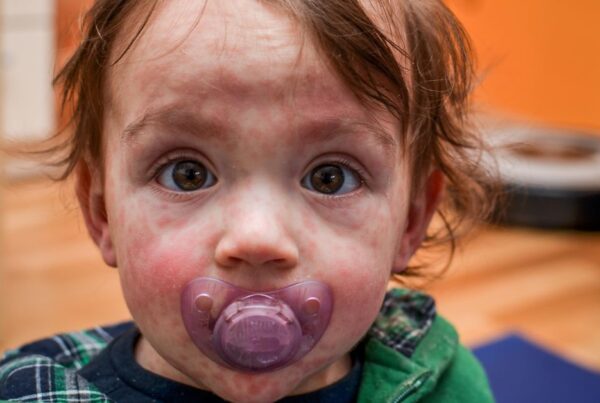Ticks are small bugs that feed on human and animal blood. Of the many different tick species found around the world, a select few bite and carry harmful pathogens that lead to tick-borne illnesses like Lyme disease (LD) or Rocky Mountain spotted fever (2). Prompt removal is important as the longer the tick remains attached to the skin, the greater the risk of disease transmission (3).
In this article, I explain when and where to look for ticks, break down how to properly and safely remove ticks, list symptoms to watch for, and discuss antibiotic treatment for tick bites.
To learn about tick bite prevention, see: 5 Expert Recommended Ways To Prevent Tick Bites – Dr Green Mom.
When And Where To Look For Ticks
Tick season in the U.S. starts around April and can last until October with June and July recording the highest numbers of tick bites (1).
Performing frequent tick checks after being outdoors especially during tick season is one of the easiest ways to assess if a tick bite may have occurred. Ticks can vary in size from being as small as a poppy seed to as big as a pencil eraser depending on the species and stage of the tick life cycle. They also range in color from reddish brown to dark brown or black. Ticks are prone to latch on to any open skin so make sure you check the belly button, armpits, back of the knees, scalp, and behind the ears, as well as between the toes and fingers (3).
If you live in a tick prone area, it’s imperative to shower within two hours of coming indoors during tick season as showering has been shown to reduce the likelihood of getting Lyme disease and may be effective in reducing the risk of other tick borne diseases as well (2). Showering may help to wash off ticks that are not yet attached to the skin (4).
How Do I Properly Remove A Tick?
If you find a tick attached to your or your child’s skin, remove the tick as soon as possible. To do this correctly, you will need a pair of clean, fine-tipped tweezers. I also recommend wearing disposable gloves to protect yourself from additional tick bites.
A Step-By-Step Guide For Tick Removal
- With the tweezers, grasp the tick as close to the skin’s surface as possible by positioning the tweezers around the tick’s mouthparts.
- Gently and steadily pull upwards when removing the tick. Avoid twisting or jerking motions that can break the tick’s mouthparts, leaving them attached to the skin.
- After removing the tick, check for residual parts. If there are any left, use tweezers to remove them.
- Thoroughly clean the bite area and your hands with rubbing alcohol or with soap and water.
- Dispose of a live tick by flushing it down the toilet or drowning it in rubbing alcohol. Do not crush a tick between your fingers.
- Optional: Take a picture of the tick or keep it in a ziplock bag or small container in your freezer for identification purposes should symptoms arise. Or send it off for comprehensive tick analysis at tickreport.com or similar lab testing.
Once the tick is properly removed, immediately contact your healthcare provider and watch for symptoms. Seek medical attention if you are unsure if the tick was completely removed, if the tick is embedded too deeply, or if there are any adverse reactions, such as swelling, pain, or severe itching after removal (5).
Signs And Symptoms Of Tick-Related Diseases
Because ticks can carry a wide range of diseases and transmit multiple tick-borne infections at once, it’s important to know the symptoms to look for.
Bulls Eye Rash
About 80% of tick bite cases remain localized to the site of the bite, including the ‘bull’s-eye’ rash.
This rash is the most common early sign of LD that begins as a reddened area. As the rash grows in size (up to 12 inches in diameter), it clears in the middle and develops a red ring around the outside (2). However, not everyone with LD will develop the bulls-eye rash. Note that the rash will not appear this way on darker skin tones; instead, it will appear as a dark brown area in the center with a light pink halo as the rash spreads.
Flu-Like Symptoms
Other symptoms that may present within 3 to 30 days after a tick bite include a fever (usually around 102 or 103°F), headache, low energy, extreme weakness, muscle and joint aches, and swollen lymph nodes – especially under the chin, along the sides of the neck, and in your armpits (2).
Asymmetrical Arthritis Or Facial Palsy
In about 10-20% of cases, the bacteria responsible for conditions like LD can spread to other parts of the body leading to asymmetrical arthritis or facial palsy in which you may observe sudden weakness or paralysis on one or both sides of your face with a drooping eyebrow or mouth (2).
Changes In Mood, Appetite, Or Coordination
Keep a watch, if after spending time outdoors during tick season, your child is having sudden changes to their mood, there is a decline in school performance, they lose their appetite, or there’s a decrease in their speech or motor coordination as these are all possible signs of tick-borne infections.
The good news is that early treatment of tick-borne infections or diseases can significantly improve outcomes and reduce the risk of complications.
Recommended Medication Guidelines For Treatment Of Lyme Disease
In the United States, Lyme Disease is the most common tick-borne disease. Since it is complex and can be very difficult to treat, a round of prophylactic antibiotic therapy is appropriate to prevent the onset of infection for those who have had a blacklegged tick bite (6).
The International Lyme and Associated Diseases Society (ILADS) states that while an optimal treatment regimen has not yet been determined, ILADS does recommend a 20-day course of 100-200 mg of doxycycline taken twice daily. They recommend against a single-dose of doxycycline as that has not been shown in studies to be effective at preventing LD (6). It’s important to speak with your doctor if your child has been bitten by a tick as dosing is determined by age & weight and there are other medication options to consider if doxycycline is not appropriate. For more information about treatment guidelines and pediatric dosing, visit ILADS to learn more.
A Note About Testing For Lyme Disease
The general consensus is that Lyme Disease is a clinical diagnosis and testing is not necessary when a patient has the bulls-eye rash and a history of being exposed to ticks. However, testing can provide more information. Testing immediately after a bite is unlikely to give a positive result because the body’s immune system takes about 4-6 weeks to produce antibodies against the infection (7). If you do an initial test after a bite and the results come back negative, re-testing should be done at 5-6 weeks.
Summary
Ticks are small bugs that can potentially transmit diseases. If you are prone to spending time outdoors in a known tick area, it‘s important to know how to check for and properly remove ticks and the symptoms to look for after a tick bite since early detection and treatment are critical.
References:
- Read, Jennifer S. (2019); Tickborne Diseases in Children in the United States. Pediatr Rev August, 40 (8): 381–397. https://doi.org/10.1542/pir.2018-0304
- Bryant, K. A., et al. (2000). Clinical manifestations of tick-borne infections in children. Clinical and diagnostic laboratory immunology, 7(4), 523–527. https://doi.org/10.1128/CDLI.7.4.523-527.2000
- Rahlenbeck, S., et al. (2016). Prevention of tick-borne diseases: an overview. The British journal of general practice : the journal of the Royal College of General Practitioners, 66(650), 492–494. https://doi.org/10.3399/bjgp16X687013
- Kugeler, K. J., et al. (2022). Changing Trends in Age and Sex Distributions of Lyme Disease-United States, 1992-2016. Public health reports (Washington, D.C. : 1974), 137(4), 655–659. https://doi.org/10.1177/00333549211026777
- Removing a Tick. (May 13, 2022). Centers for Disease Control and Prevention. https://www.cdc.gov/ticks/removing_a_tick.html
- Daniel J Cameron, et al. (2014). Evidence assessments and guideline recommendations in Lyme disease: the clinical management of known tick bites, erythema migrans rashes and persistent disease, Expert Review of Anti-infective Therapy, 12:9, 1103-1135, https://doi.org/10.1586/14787210.2014.940900
- How to Handle a Tick Bite. (2023). International Lyme and Associated Diseases Educational Foundation. https://iladef.org/education/how-to-handle-a-tick-bite/



One Comment